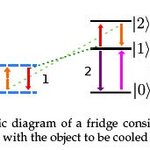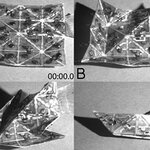Applied Physics

In almost everything, size matters. And usually, being bigger helps. I don't know anyone who couldn't use a larger refrigerator but University of Bristol physicists have done the unthinkable and made the smallest refrigerator ever.
As accepted in the semiconductor business, nature itself places limitations on small size, not engineers. The Bristol team, professor Noah Linden, professor Sandu Popescu and Paul Skrzypczyk, say in their arXiv paper there is no minimum size and wanted to seek out any fundamental dimensional limits to thermodynamic machines and designed…

Fish in a wind tunnel? How else will you learn how they fly?
It turns out flying fish can remain airborne for over 40 seconds and cover distances of up to a quarter mile hitting a top speed up to 40 miles an hours, says Haecheon Choi, a mechanical engineer from Seoul National University, Korea. Choi said a children's science book inspired him to look into the aerodynamics of flying fish, and a paper of his results appear in The Journal of Experimental Biology. Choi and colleague Hyungmin Park posted similar results in a poster for the American Physical Society meeting in 2006.To…

I took a moment to look at Ray Kurzweil's response to PZ Myers' second-hand dissection of his talk at the Singularity Summit(1) I attended last weekend (see The Singularity Stole My ATM Card) because Andrea Kuszewki is on the case and trying to keep things on track (like, can we reverse engineer the brain? Good luck injecting science back into the pissing contest between those two, Andi!) and I came across this gem so I am taking a moment from reading Garth Sundem's new book, "Brain Candy" (review this weekend!) to talk about it. Ray Kurzweil says:
The amount of information in…

Traditional mirrors work by directing the path of photons of light but atoms possessing a magnetic moment can likewise be controlled using a magnetic mirror. A new study investigates the feasibility of using magnetic domain walls to direct and ultimately trap individual atoms in a cloud of ultracold atoms.
We have investigated pinning potentials created by inter-domain wall magnetostatic interactions in planar magnetic nanowires. We show that these potentials can take the form of an energy barrier or an energy well depending on the walls’ relative monopole moments, and that the…
Researchers have reported the creation of pseudo-magnetic fields far stronger than the strongest magnetic fields ever sustained in a laboratory, just by putting the right kind of strain onto a patch of graphene.
Graphene is a form of carbon that consists of a single layer of carbon atoms. A carbon atom has four valence electrons. In graphene (and in graphite, a stack of graphene layers), three electrons bond in a plane with their neighbors to form a strong hexagonal pattern, like chicken-wire. The fourth electron sticks up out of the plane and is free to hop from one atom to the…

Elementary calculations show that the mass of the passenger's vehicle should have an important influence on risk of injury, greater mass yielding greater protection independent of the other mass(es) in the collision. This holds for collisions treated either as purely elastic, or as quasi-inelastic. Passengers in more massive vehicles thus would seem better off no matter what the size or weight of other vehicle(s) in a collision.The approximations used suggest that highway vehicles should be at least 20 times the mass of the average passenger, or injuries in a collision will be…

It's World Cup time and that means sports fans worldwide are focused on important issues, like complaining about vuvuzelas and this year's soccer ball, the Jabulani, which will push fan and player hatred of the 2006 ball, Teamgeist, into the background.
Why does this happen (the ball complaints, not the vuvuzelas) every World Cup? FIFA, governing body of Big Football, loves controversy, that's why. So FIFA has strict regulations on the size and weight of the balls but makes no regulations at all about the outside surface of the balls. Thus, we go from an inordinately smooth ball…

If you've watched any World Cup games so far (and a record 15 million in the US watched Saturday's match versus Ghana, so statistically, ummm, 50,000 people in our audience have watched at least one) you may have heard an omnipresent buzzing sound and assumed it was a horde of mutant bees in the broadcast booth or a defect in your television.
It was neither. Instead, it was a vuvuzela ("lepatata"), a B flat plastic horn that is loved by South African sports fans and hated by everyone else. Seriously. During that first World Cup match I watched it was so annoying I was…

Researchers at Harvard and MIT using what is called programmable matter have demonstrated how a single thin sheet composed of interconnected triangular sections could transform itself into a boat- or plane-shape, all without the help of people.
They envision creating smart cups that could adjust based upon the amount of liquid needed or maybe a Swiss army knife that could change from a wrench to a tripod - obviously readers here envision giant robots that could smite our foes.
The sheet, a thin composite of rigid tiles and elastomer joints (with elastic polymers), is studded with thin foil…

The beauty and utility of crystalline materials has seen in almost every application today. From silicon microprocessor and photovoltaic technologies, to dielectrics, laser applications, optics (particularly infrared optics), armors and abrasion resistant materials, and many other sorts of solid states. As a physicist who has turned to materials science as a field of study, the power of symmetry seems undeniable - allowing us to compute and estimate (given the intense modeling efforts and attention of many scientists) many of the physical, optical, electrical and magnetic…